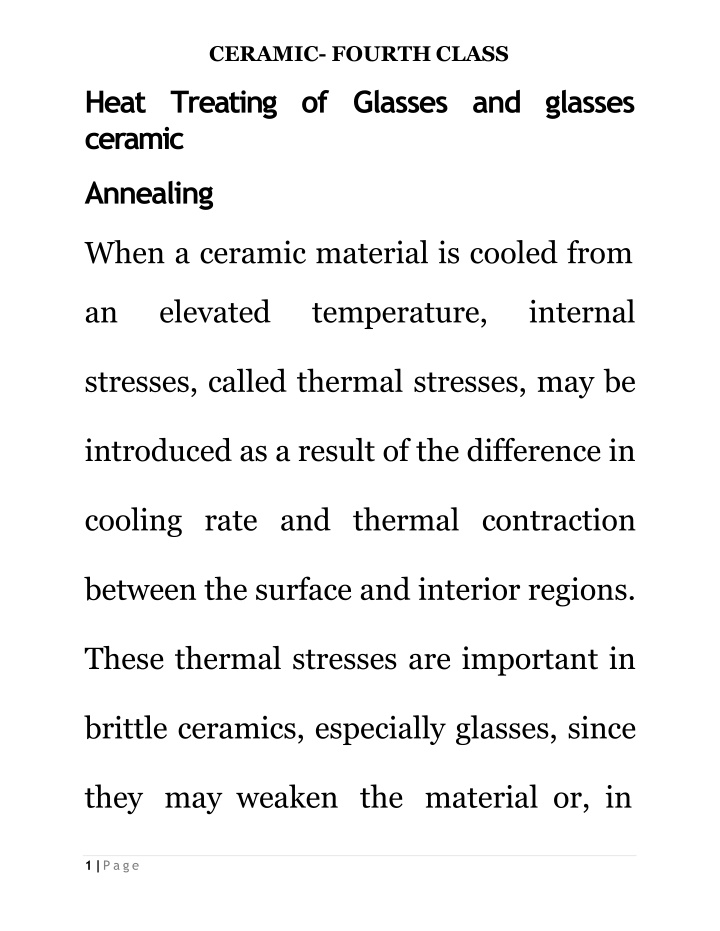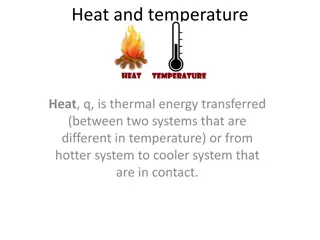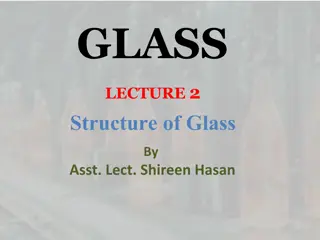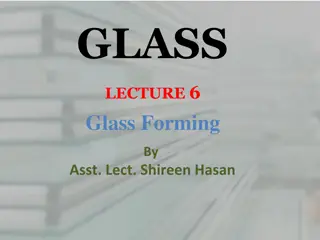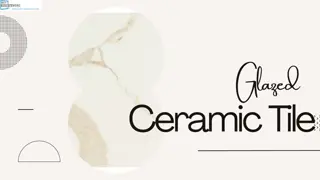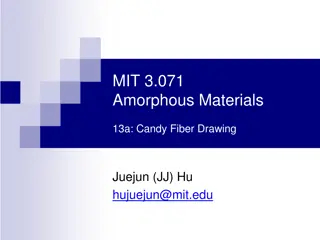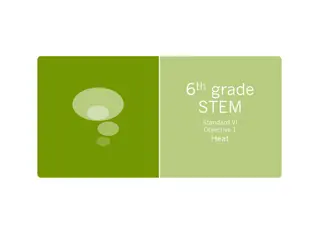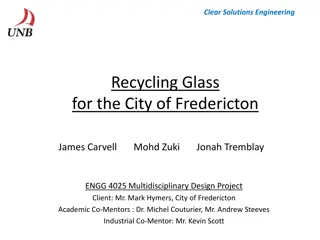Ceramic Heat Treatment and Glass Strengthening Techniques
Internal stresses in ceramics, especially glasses, can lead to thermal shock or fracture. Learn about heat treatment methods like annealing and tempering to eliminate or reduce these stresses and enhance the strength of glass materials.
Download Presentation

Please find below an Image/Link to download the presentation.
The content on the website is provided AS IS for your information and personal use only. It may not be sold, licensed, or shared on other websites without obtaining consent from the author.If you encounter any issues during the download, it is possible that the publisher has removed the file from their server.
You are allowed to download the files provided on this website for personal or commercial use, subject to the condition that they are used lawfully. All files are the property of their respective owners.
The content on the website is provided AS IS for your information and personal use only. It may not be sold, licensed, or shared on other websites without obtaining consent from the author.
E N D
Presentation Transcript
CERAMIC- FOURTH CLASS Heat Treating ceramic of Glasses and glasses Annealing When a ceramic material is cooled from an elevated temperature, internal stresses, called thermal stresses, may be introduced as a result of the difference in cooling rate and thermal contraction between the surface and interior regions. These thermal stresses are important in brittle ceramics, especially glasses, since they may weaken the material or, in 1| P a g e
CERAMIC- FOURTH CLASS extreme cases, lead to fracture, which is termed thermal shock. Normally, attempts are made to avoid thermal stresses, which may be accomplished by cooling the piece at a sufficiently slow rate. Once such stresses have been introduced, however, elimination, or at least a reduction in their magnitude, is possible by an annealing heat treatment in which the glass is heated to the 2| P a g e
CERAMIC- FOURTH CLASS annealing point, then slowly cooled to room temperature. GlassTempering The strength of a glass piece may be enhanced by intentionally inducing (generating) compressive residual surface stresses. This can be accomplished by a heat treatment procedure called thermal tempering. With this technique, the glassware is heated to a temperature below the 3| P a g e
CERAMIC- FOURTH CLASS softening point. It is then cooled to room temperatureinastreamofairor,insome cases, an oil bath. The residual stresses arise from differences in cooling rates for surface and interior regions. Initially, the surface cools more rapidly and, once having dropped to a temperature below the strain point, becomes rigid. At this time, the internal parts of the glassware, having cooled less rapidly, is at a higher temperature(abovethestrainpoint)and, 4| P a g e
CERAMIC- FOURTH CLASS therefore, is still plastic. With continued cooling, the interior attempts to contract to a greater degree than the now rigid exterior will allow. Thus, the inside tends to draw in the outside, or to impose inward radial stresses. As a consequence, after the glass piece has cooled to room temperature, it stands compressive stresses on the surface, with tensile stresses at interior regions. The room- temperature stress distribution over a 5| P a g e
CERAMIC- FOURTH CLASS cross section of a glass plate is represented schematically in Figure 2. The failure of ceramic materials almost always results from a crack that is initiated at the surface by an applied tensile stress. To cause fracture of a tempered glass piece, the magnitude of an externally applied tensile stress must be great enough to first overcome the residual compressive surface stress and, in addition, to stress the surface in 6| P a g e
CERAMIC- FOURTH CLASS tension sufficiently to initiate a crack, which may then propagate. For an untempered glass, a crack will be introduced at a lower external stress level, and, consequently, the fracture strength will be smaller. Tempered glass is used for applications in which high strength is important; these include large doors and eyeglass lenses. 7| P a g e
CERAMIC- FOURTH CLASS Figure distribution over the cross section of a tempered glass plate. 2: Room-temperature residual stress 8| P a g e
CERAMIC- FOURTH CLASS FABRICATION AND PROCESSING OFCLAY PRODUCTS This class of materials includes the structural clay products and the whitewares. In addition to clay (being composed of alumina (Al2O3) and silica (SiO2)), many of these products also contain other ingredients. After having been formed, pieces most often must be subjected to drying and firing operations; each of the ingredients influences the 9| P a g e
CERAMIC- FOURTH CLASS changes that take place during these processes and the features of the finished piece. The as-mined raw materials usually have to go through a milling or grinding operation in which particle size is reduced; this is followed by screening or sizing to produce a powdered product having a desired range of particle sizes. For multicomponent systems, powders must be thoroughly (totally) mixed with 10| P a g e
CERAMIC- FOURTH CLASS water and perhaps other ingredients to give flow characteristics that are compatible with the particular forming technique. The formed piece must have sufficient mechanical strength to remain intact during transporting, drying, and firing operations. Two common shaping techniques are utilized for forming clay- based compositions: hydroplastic forming and slip casting. 11| P a g e
CERAMIC- FOURTH CLASS HydroplasticForming As mentioned above, clay minerals, when mixed with water, become highly plastic and flexible and may be molded without cracking; however, they have extremely low yield strengths. The consistency (water clay constant ratio) of the hydroplastic mass must give a yield strength sufficient to permit a formed ware to maintain its shape during handling and drying. 12| P a g e
CERAMIC- FOURTH CLASS The most common hydroplastic forming technique is extrusion, in which a stiff plastic ceramic mass is forced through a die cavity having the desired cross- sectional geometry; it is similar to the extrusion of metals. Brick, pipe, ceramic blocks, and tiles are all commonly fabricated using hydroplastic forming. Slip Casting(solid anddrain) Another forming process used for clay- based compositions is slip casting. Aslip 13| P a g e
CERAMIC- FOURTH CLASS is a suspension of clay and/or other nonplastic materials in water. When poured into a porous mold, water from the slip is absorbed into the mold, leaving behind a solid layer on the mold wall the thickness of which depends on the time. This process may be continued until the entire mold cavity becomes solid (solid casting). Or it may be finished when the solid shell wall reaches the desired thickness, by inverting the mold and 14| P a g e
CERAMIC- FOURTH CLASS pouring out the excess slip; this is termed drain casting.As the cast piece dries and shrinks, it will release from the mold wall; at this time the mold may be disassembled (take to pieces) and the cast piece removed. The nature of the slip is extremely important; it must have a high specific gravity and yet be very fluid and pourable. These characteristics depend on the solid to water ratio and other agents that are added. An 15| P a g e
CERAMIC- FOURTH CLASS acceptable casting rate is an essential requirement. In addition, the cast piece must be free of bubbles, and it must have a low drying shrinkage and a relatively high strength. 16| P a g e
CERAMIC- FOURTH CLASS The properties of the mold itself influence the quality of the casting. Normally, plaster of Paris, which is economical, relatively easy to fabricate into 17| P a g e
CERAMIC- FOURTH CLASS complicated shapes is used as the mold material. Most molds are multipiece items that must be assembled before casting. Also, the mold porosity may be diverse to control the casting rate. The relatively complex ceramic shapes that may be produced by means of slip casting include art objects, and specialized scientific laboratory ware such as ceramic tubes. 18| P a g e
